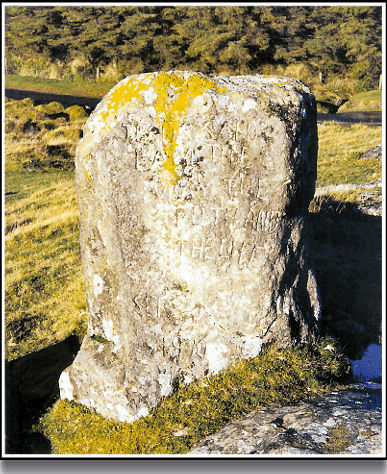
Just beside the road that leads into Fernworthy Plantation stands a lone inconspicuous stone called ‘The Heathstone’. This large boulder bears a modern description that detracts from its undoubted antiquity and one might postulate it is another example of a Christianised pagan stone.
The stone is mentioned in both the 1240 and 1609 perambulations, in these early forest bounds it is noted as,
“et inde linealiter usque ad Langestone (Yessetone) (1240); and from thence lineallie nere one mile to Yeston, al’s Geston, now commonly called Hethstone (1609),” Brewer, 2002, p.25.
The etymology of the name seems to have mutated from Yeston through to Hethstone on to Heath’s Stone then to Halfstone, finally ending up at The Heath Stone. William Crossing, 1990, p. 66 is firmly of the belief that the actual stone was once a Bronze menhir that was later used as a guidestone and then incorporated into an enclosure. He does get a trifle excited when he suggests:
“Its name, and that of the ridge on which it stood (Hurston Ridge) are plainly indicative of its origin, while its situation on the forest boundary line renders clear the purpose it served later. The Saxon hare-stane, or hoar stone is a cognate term with the Celtic men-hir, high, or long stone, and that these ancient monoliths were often fixed upon as boundaries there is ample proof; indeed, there is evidence that the Saxon name in question also denoted that purpose. That Hurston Ridge derived its name in Saxon times from the hare-stane that stood upon it we may regard as certain (the farm of Hurston, which is named after the ridge, actually appears as Hareston in a foresters account of the time of Henry VII.), and it is not difficult to see how the stone itself would in time come to be called Hethstone, and later Heath Stone.“
It could be that Crossing used two different interpretations here, firstly there are the Saxon words hea/heah meaning ‘high’ and stane – stone, which would equate, as he notes, to the Celtic menhir, i.e. ‘high stone’. But ‘hoar stone’ would indicate an old white/grey, from the word har, Griffiths, 2004, pp. 30,33. Which if other examples of the name are anything to go by is the one tended to be used for boundary/guide stones. The English place-name society tend to look at things a bit differently, they suggest that in fact ‘Hurston’ indicates either Heort’s tun (farm) being a personal name or Heort tun – ‘farm of the hart’, Gover et al, 1998, p.426.

The Heath Stone.
As previously mentioned, the Heath Stone now carries an inscription that was cut in 1979 by the supervisor of the Fernworthy Reservoir, Sydney Potter. It reads, “JESUS SAID I AM THE WAY, THE TRUTH AND THE LIFE, SEPT 1979.” It appears that for displaying his convictions he incurred the censure of what Hemery describes as, “officialdom.”
So if you are ever going to Fernworthy, stop off just before the first gate and pay a visit to a small part of Dartmoor’s history, it is very close to the road.
Reading List.
Brewer, D. 2002 Dartmoor Boundary Markers, Halsgrove Pub., Tiverton.
Crossing, W. 1990 Crossing’s Guide to Dartmoor, Peninsula Press, Newton Abbot.
Gover, J.E.B., Mawer, A., & Stenton, F. M. 1992 The Place-Names of Devon, The English Place Name Society, Nottingham.
Griffiths, B. 2002 A Dictionary of Old English, Heart of Albion Press, Loughborough.
Hemery, E. 1983 High Dartmoor, Hale, London.
 Legendary Dartmoor The many aspects past and present of Dartmoor
Legendary Dartmoor The many aspects past and present of Dartmoor
